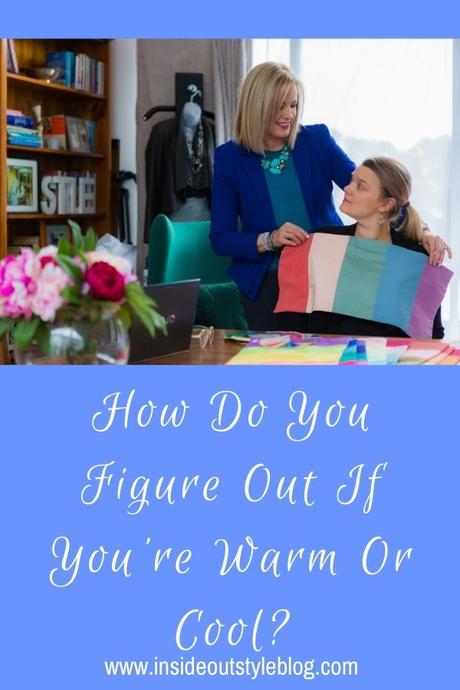



Have you wondered about which colours really make you shine?
If you’re not sure, one of the first colour challenges you face is figuring out if you have a warm or cool skin undertone.
There are various analysis systems out there and each is very different from each other. When we consider colour analysis, we have to have a system that actually gives us enough variety. Many of the older colour analysis systems are quite limited and they just don’t work for everybody, which is why you may have been given conflicting advice depending on the system used.
One of the reasons I developed the Absolute Colour System of 18 colour palettes was because I identified that there weren’t enough options, and I was forced to put someone into a less than ideal palette rather than having one that worked for them.
Discover here how 9 ways knowing best colours will change your life as well as your wardrobe.
How do You Figure Out if You Have a Warm or Cool Skin Undertone?
Science of Colour
Light is made up of wavelengths of light, and each wavelength is a particular colour. White light, as in the proportions in sunlight, is actually made of all of the colours of the rainbow because it contains all wavelengths of all the colours, and it is described as polychromatic light. An object is seen as black if it absorbs all colours of white light. A white object reflects all colours of white light equally.
For example, a red shirt looks red because the dye molecules in the fabric have absorbed the wavelengths of light from the visible electromagnetic spectrum apart from red. Red light is the only light that is reflected from the shirt.
Colour Properties
Albert Munsell was the man who figured out that colour wasn’t just one thing – but a combination of several elements, that I’ve written about here
- Value – Light to Dark (tints to shades)
- Chroma – Intensity or Saturation (brightness to mutedness)
- Undertone – Warmth to Coolness (blue based or yellow based colours)
Everything we wear reflects its colour on us and that reflected colour can either make us look healthier and be in harmony with us or they can be at odds. When we determine your undertones, it also needs to relate to your intensity and value as well as the undertone, which is something I look for when doing personal colour analysis.
Determining Your Best Colours
During a personal colour analysis, you are draped in specifically-coloured fabrics that are gradually narrowed down to find your perfect palette. When I’m determining someone’s colours, if I put on drapes that are too bright for the person, it’s very hard to work out if they are warm or cool because the intensity or brightness of the colours dominates and distracts, particularly if you have more muted colouring. Similarly, if I drape someone and the value is too dark, it doesn’t matter if it’s the warm side or the cool side it’s too dark and it just feels heavy and it does not feel related.
In colour analysis we are striving for balance and harmony between you and the colours. So when I’m looking at someone’s colours, I start with a drape of similar intensity and similar value and then I can compare warm and cool. It’s important to remember that your colours change over time too (we all know about the pigments in our hair changing – we lose pigment and hair goes grey then white), not only is your hair losing pigment, your skin and eyes also lose pigment. It’s important to reevaluate your colours ate least every 10-15 years or when you feel that the colours you’re wearing just aren’t as good as they were, or if you have a radical hair colour change!
Colour Draping At Home
Play with different colours and watch in a mirror just how much the colour changes your appearance. Place two scarves or tops over each other (in good natural lighting) then take the top colour away as you stare intently at your face. Start with a cool blue-based pink and an orange.
- See how your complexion changes and if your eyes brighten or become dull and if your skin looks more even and brighter or duller and less even. Notice if you want to look at the colour (there is a pull to the colour) or your focus is fully on your face.
- Look for the colours that seem to make you light up, as if a switch has been turned on and a light inside you is illuminating your complexion.
Don’t spend your time examining your veins or wrists. I’ve had clients whose facial colouring was different from their arms, as arms get a lot more sun damage than faces (on the whole). It’s your face that is your focal point, your communication centre and what looks healthy or unhealthy – so it’s way more important than your wrists will ever be!
Keep in mind, if you have a dramatic personality, you might be drawn to brighter colours because they are more dramatic, whether or not they suit you. There is an element of personality where you are choosing brighter colours because it relates to your personality and love of being bold. There are ways of wearing your more flattering muted colours and still express your bold and dramatic personality, find out more here.
If you’d like my professional opinion on your contrast and colours, if you can’t see me in person for a personal colour analysis, I offer this as part of my 7 Steps to Style program (along with body shape analysis and a whole lot more!).
Further reading
Discover Your Colours – Warm or Cool?
Understanding Colour Systems and Personal Colour Analysis
Discover Your Colours – Your Intensity – Clear or Soft
Discover Your Colours – Skin Undertone,Overtone & Makeup






